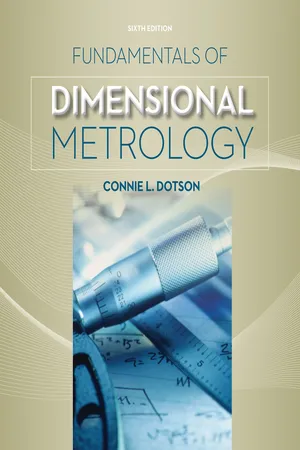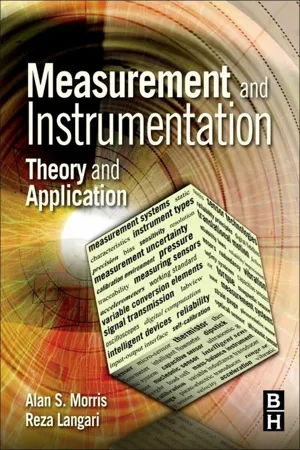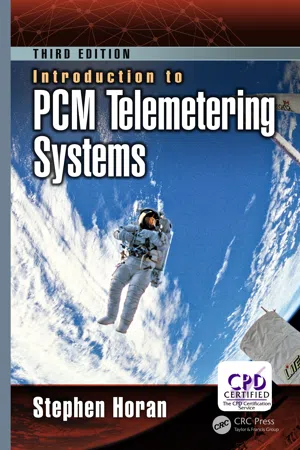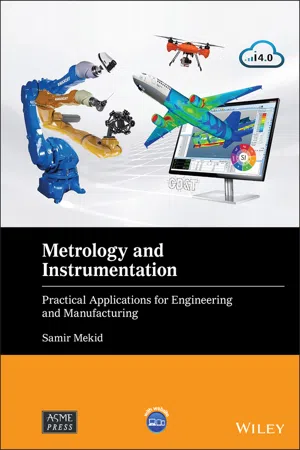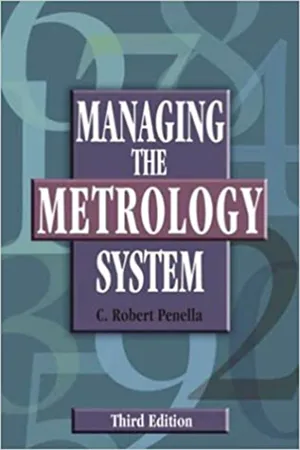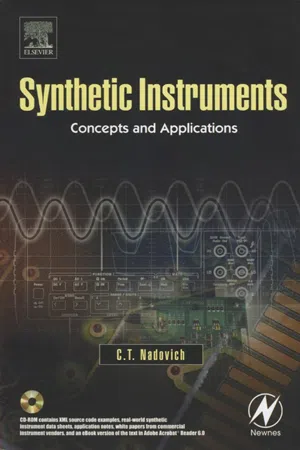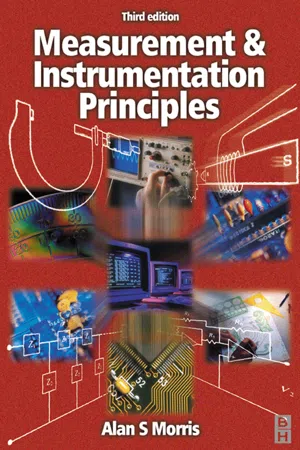Technology & Engineering
Calibration
Calibration is the process of adjusting and comparing the measurements of an instrument or device to ensure its accuracy and precision. This involves setting the instrument to a known standard or reference value. Calibration is essential for maintaining the reliability and consistency of measurement instruments, ensuring that they provide accurate results.
Written by Perlego with AI-assistance
Related key terms
1 of 5
8 Key excerpts on "Calibration"
- eBook - PDF
- Connie Dotson(Author)
- 2015(Publication Date)
- Cengage Learning EMEA(Publisher)
224 9 Calibration is not a cure-all for measurement problems; it only determines adherence to standards. As we have emphasized, accuracy is adherence to a standard; therefore, Calibration is the measurement of accuracy. With a fixed gage, the Calibration pro-cess simply determines the amount by which the gage is larger or smaller than its nominal size. With a measuring instrument, Calibration is the complex relationship between a change in input and a change in output. OVERVIEW Very often, a user calibrates an instrument meticulously, and then goes back to work and repeats the same er-rors again and again. A calibrated instrument may give many users a false sense of security—if the instrument is set correctly, the measurement must be right—but cali-bration may mask more serious errors. Error can cause problems, but properly applied Calibration methods can reduce or even eliminate these problems. LEARNING OBJECTIVES ● Explain the role of Calibration. ● Describe the significance of traceability. ● Explain the effect of errors. ● Describe general Calibration techniques. ● State the limitation of the 10-to-1 rule. Calibration . . . let it not be feared that erroneous deductions may be made from recorded facts: the errors which arise from the absence of facts are far more numerous and durable than those which result from unsound reasoning respecting true data. Charles Babbage (1792–1871) (Nineteenth-century English inventor who conceived the computer as an instrument for research) CHAPTER NINE Copyright 2016 Cengage Learning. All Rights Reserved. May not be copied, scanned, or duplicated, in whole or in part. Due to electronic rights, some third party content may be suppressed from the eBook and/or eChapter(s). Editorial review has deemed that any suppressed content does not materially affect the overall learning experience. Cengage Learning reserves the right to remove additional content at any time if subsequent rights restrictions require it. - eBook - ePub
Measurement and Instrumentation
Theory and Application
- Alan S. Morris, Reza Langari(Authors)
- 2011(Publication Date)
- Butterworth-Heinemann(Publisher)
4.2. Principles of Calibration
Calibration consists of comparing the output of the instrument or sensor under test against the output of an instrument of known accuracy when the same input (the measured quantity) is applied to both instruments. This procedure is carried out for a range of inputs covering the whole measurement range of the instrument or sensor. Calibration ensures that the measuring accuracy of all instruments and sensors used in a measurement system is known over the whole measurement range, provided that the calibrated instruments and sensors are used in environmental conditions that are the same as those under which they were calibrated. For use of instruments and sensors under different environmental conditions, appropriate correction has to be made for the ensuing modifying inputs, as described in Chapter 3 . Whether applied to instruments or sensors, Calibration procedures are identical, and hence only the term instrument will be used for the rest of this chapter, with the understanding that whatever is said for instruments applies equally well to single measurement sensors.Instruments used as a standard in Calibration procedures are usually chosen to be of greater inherent accuracy than the process instruments that they are used to calibrate. Because such instruments are only used for Calibration purposes, greater accuracy can often be achieved by specifying a type of instrument that would be unsuitable for normal process measurements. For instance, ruggedness is not a requirement, and freedom from this constraint opens up a much wider range of possible instruments. In practice, high-accuracy, null-type instruments are used very commonly for Calibration duties, as the need for a human operator is not a problem in these circumstances.Instrument Calibration has to be repeated at prescribed intervals because the characteristics of any instrument change over a period. Changes in instrument characteristics are brought about by such factors as mechanical wear, and the effects of dirt, dust, fumes, chemicals, and temperature change in the operating environment. To a great extent, the magnitude of the drift in characteristics depends on the amount of use an instrument receives and hence on the amount of wear and the length of time that it is subjected to the operating environment. However, some drift also occurs even in storage as a result of aging effects in components within the instrument. - eBook - ePub
- Stephen Horan(Author)
- 2017(Publication Date)
- CRC Press(Publisher)
ATLAB ®, or other packages for making the computations. The reader is encouraged to use these packages whenever possible rather than making the computations by hand.3.3 BASICSBefore beginning the mathematical techniques, we first look at issues related to Calibration and data modeling. The two uses have different approaches and needs, even if the mathematical tools are the same.3.3.1 CalibrationCalibration has several official definitions. The International Vocabulary of Metrology (VIM) defines Calibration as anA more operational definition for Calibration is theoperation that, under specified conditions, in a first step, establishes a relation between the quantity values with measurement uncertainties provided by measurement standards and corresponding indications with associated measurement uncertainties and, in a second step, uses this information to establish a relation for obtaining a measurement result from an indication [VIM12 ].process of determining the numerical relationship, within an overall stated uncertainty, between the observed output of a measurement system and the value, based on standard sources, of the physical quality being measured [IEEE100 ].From this, we see two approaches that the experimenter should follow: certifying that the measurement is within some pre-approved standard range for the measurement, and determining the amount of deviation from the desired standard and then documenting that quantity numerically. In the first case, the experimenter adjusts the instrument to correct improper readings. In the second case, adjustment may be possible but it may also be adequate to leave the instrument alone and apply the numerical corrections to the measurements to give the correct result. Both techniques require that the experimenter apply known standard inputs to the instrument and the resulting output observed. In this chapter, we concentrate on the analysis methods. The result of the process is to provide some form of a mapping, i.e., a mathematical function or curve, diagram, or table, to express the result for users. - eBook - ePub
Metrology and Instrumentation
Practical Applications for Engineering and Manufacturing
- Samir Mekid(Author)
- 2021(Publication Date)
- Wiley-ASME Press Series(Publisher)
Performance Qualification (PQ) verifies equipment performance through its routine analytical use to measure conformance to specifications. The measured values are checked against a certified simulator or control standards. Standards are used that have similar values to the test samples. This establishes the suitability of the device for its intended use.10.6 Difference between Calibration and Validation of Equipment
Equipment Calibration deals with assessing the accuracy of equipment's results by measuring the variation against a defined standard to decide upon the relevant correction factors. The equipment is accordingly adjusted to fine‐tune its performance to tally with accepted standards or specifications.Equipment validation is a documented assurance that each constituent of the equipment is complying with the manufacturer's specification under a defined operating environment and standard. This is pulled off by checking the performance against traceable control standards.10.7 Difference between Calibration and Verification
Calibration and verification are often used interchangeably across the scientific disciplines, but that is incorrect. They are not the same thing. Calibration is where instruments are tested for accuracy against a specified standard, and thereby the lack of trueness is compensated while correction is applied. Verification is the maximum accepted error and is not possible without the preceding Calibration. Both terms are very closely related and hence used interchangeably accidentally.Qualification means documented assurance that equipment (or facilities, utilities, etc.) are suitable for intended use. Validation is objective evidence that a PROCESS or PROCEDURE (including analytical methods) result in a consistent output meeting quality specifications. Qualification and validation are therefore related but are not the same at all. Please see “FDA Process Validation Guideline” (Jan. 2011) and/or ASTM E 2500‐07 for details. - eBook - PDF
Automotive Quality Systems Handbook
ISO/TS 16949:2002 Edition
- David Hoyle(Author)
- 2005(Publication Date)
- Butterworth-Heinemann(Publisher)
Adjustment of devices (7.6b) The standard requires measuring equipment to be adjusted or re-adjusted as necessary . 532 Product realization What does this mean? Adjustment is only possible with devices that have been designed to be adjustable. Why is this necessary? This requirement responds to the Process Approach Principle. When a measuring device is verified, it may be found within specification and adjusted if the parameters have drifted towards the upper or lower limits. If the device is found outside specification it can be adjusted or re-adjusted (on subsequent occasions) within the specified limits. How is this implemented? Mechanical devices are normally adjusted to the null position on Calibration. Electronic devices should only be adjusted if found to be outside the limits. If you adjust the device at each Calibration you will not be able to observe drift. Adjustments, if made very fre-quently, may also degrade the instrument. If the observed drift is such that the device may well be outside the specified limits by the next Calibration, adjustment will be necessary. In addition to calibrating the devices, you will need to carry out preventive and corrective maintenance in order to keep them in good condition. Preventive maintenance is maintenance to reduce the probability of failure, such as cleaning, testing, inspecting, replenishment of consumables, etc. Corrective maintenance is concerned with restoring a device (after a failure has occurred) to a condition in which it can perform its required function. These activities may cover a wide range of skills and disciplines depending on the nature of the measuring devices you use. It will include software development skills if you use test software, for instance, or electronic engineering if you use electronic equipment. You can of course subcontract the complete task to a specialist who will not only maintain the equipment but, on request, carry out Calibration. - eBook - PDF
- C. Robert Pennella(Author)
- 2004(Publication Date)
- ASQ Quality Press(Publisher)
Calibration System Description 39 Figure 2.17 A sample certificate of inspection. Continued inspection equipment, M&TE, and some instruments that they classify as their measurement standards. An independent Calibration will calibrate all other measurement standards and working instruments that a product manufacturer has elected to be calibrated by an outside Calibration source. Feedback data are reviewed and analyzed by the metrology manager or a designated representative at the time of Calibration or shortly thereafter to determine: • The adequacy of established Calibration intervals • Whether there is a need to adjust Calibration intervals • Whether there is a need to modify established Calibration procedures • The adequacy of the Calibration system and equipment reliability • The identification of out-of-tolerance equipment and the prevention of the use of that equipment until the reported deficiency has been corrected 40 Chapter Two Figure 2.17 A sample certificate of inspection. Continued Calibration System Description 41 Figure 2.18 NIST report of Calibration. Reprinted with permission from NIST, United States Department of Commerce, National Institute of Standards and Technology, Gaithersburg, Maryland 20899. Report of Calibration Page 1 of 1 For: # of blocks Serial no. __________________________________________ Submitted by: Company name Address These gage blocks were compared with the standards of the United States. The comparison process employs electromechanical comparators and four gage blocks (two standards and two test blocks) in a least squares intercomparison schedule designed to eliminate the effects of thermal drift. This process together with its statistical analysis constitutes a continuous measurement assurance program maintained at NIST to ensure that realistic uncertainty values are assigned to the length determinations. - eBook - ePub
- Chris Nadovich(Author)
- 2004(Publication Date)
- Newnes(Publisher)
Typical rack-em-stack-em or modular instruments do not use this Calibration philosophy. Instead, they calibrate the multiple instruments that comprise the system as individual instruments. The system must be taken out of service to be calibrated. The Calibration lab may even be brought to the system in the form of a mobile Calibration cart.Uncertainty Analysis
In order to investigate and predict the uncertainty of a measurement made by a synthetic instrument, the investigator needs to establish the Calibration process. Industry practice breaks Calibration into three main areas:Primary (Standards) CalibrationOperational CalibrationCalibration VerificationPrimary Calibration is the methodology by which international metrology standards are transferred to components in the system. Operational Calibration is the methodology of conducting a measurement and applying Calibration information to raw data. Calibration verification is a process, separate from self-test or system functional test (SFT) that seeks to determine, within some defined confidence limits, if the system is currently calibrated. Once the overall Calibration methodology is established for the instrument, you can then move on to defining other Calibration and accuracy related requirements, like measurement uncertainty, bias, Calibration and accuracy analysis, drift, and aging.Stimulus Calibration
Stimulus Calibration is the process by which the stimulus to the DUT is applied at the appropriate value for the measurement. For example, a power supply will stimulate the DUT by applying a voltage. It often is crucial that voltage be exactly correct.Stimulus Calibration is related to inverse maps. The goal of stimulus Calibration is to determine how to control the stimulus system so that it generates the required output. In point of fact, the output of the stimulus system (as measured by some response system) is the independent abscissa, and the system needs to determine the dependent control commands (ordinate) that generates that desired output. Since it is reversing cause and effect, this is an inverse map. - eBook - PDF
- Alan S. Morris(Author)
- 2001(Publication Date)
- Butterworth-Heinemann(Publisher)
Professional management is essential so that the customer can be assured that an efficient Calibration system is in operation and that the accuracy of measurements is guaranteed. Calibration procedures that relate in any way to measurements that are used for quality control functions are controlled by the international standard ISO 9000 (this subsumes the old British quality standard BS 5750). One of the clauses in ISO 9000 requires that all persons using Calibration equipment be adequately trained. The manager in charge of the Calibration function is clearly responsible for ensuring that Measurement and Instrumentation Principles 67 this condition is met. Training must be adequate and targeted at the particular needs of the Calibration systems involved. People must understand what they need to know and especially why they must have this information. Successful completion of training courses should be marked by the award of qualification certificates. These attest to the proficiency of personnel involved in Calibration duties and are a convenient way of demonstrating that the ISO 9000 training requirement has been satisfied. 4.3 Calibration chain and traceability The Calibration facilities provided within the instrumentation department of a company provide the first link in the Calibration chain. Instruments used for Calibration at this level are known as working standards . As such working standard instruments are kept by the instrumentation department of a company solely for Calibration duties, and for no other purpose, then it can be assumed that they will maintain their accuracy over a reasonable period of time because use-related deterioration in accuracy is largely eliminated. However, over the longer term, the characteristics of even such standard instruments will drift, mainly due to ageing effects in components within them.
Index pages curate the most relevant extracts from our library of academic textbooks. They’ve been created using an in-house natural language model (NLM), each adding context and meaning to key research topics.
